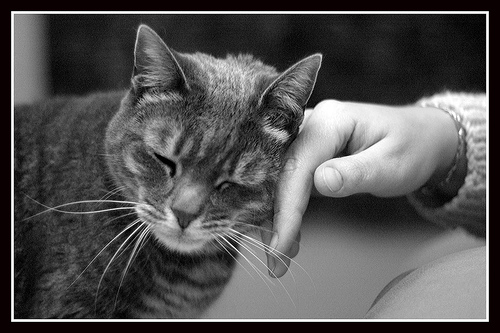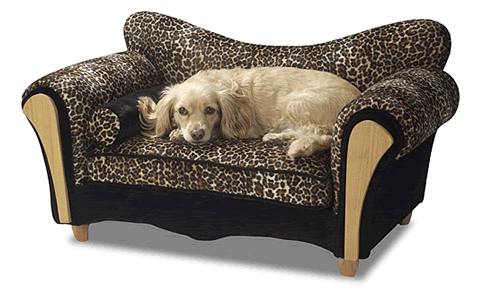 |
 |
 For
people who suffer from allergies, determining the cause of the allergy, whether
it be pollen, mold or pet dander, is the first step in living a happier,
healthier life. Discovering that you or a family member is allergic to
your beloved pet, however, is something that can be quite devastating.
Sneezing, wheezing, congestion and irritated or watery eyes are all common
symptoms of pet allergies. The allergy may be because of pet dander, or
it may be because of the animals' saliva or urine and excrement. Animal
hair is rarely the cause of allergies, which means that the myth of
short-haired animals being a better choice for those with allergies is just
that - a myth. For
people who suffer from allergies, determining the cause of the allergy, whether
it be pollen, mold or pet dander, is the first step in living a happier,
healthier life. Discovering that you or a family member is allergic to
your beloved pet, however, is something that can be quite devastating.
Sneezing, wheezing, congestion and irritated or watery eyes are all common
symptoms of pet allergies. The allergy may be because of pet dander, or
it may be because of the animals' saliva or urine and excrement. Animal
hair is rarely the cause of allergies, which means that the myth of
short-haired animals being a better choice for those with allergies is just
that - a myth.
Having allergies doesn't mean you have to give up your pet right away,
however. There are a number of solutions that can be attempted
first. Take stock of your living situation. Rather than giving the
animal free run of the house, restrict them to only certain rooms or increase
the amount of time they spend outside. Make sure that the litter box is
out of the way. Make the bedroom of the affected person completely off
limits to the dog or cat. Run HEPA air filters and clean your home,
especially carpets, often. Have the person with allergies avoid as much
contact with the animal as possible, assuming there are other family members
who can still love on and play with the animal. Give the animal frequent
baths to remove dander, dust, pollen, dirt and spores, which are likely the
cause of the allergy.
In the most severe cases where the animal cannot be removed from the house, or
contact with animals is necessary, allergy shots can be an option. If you
have allergies and desire to have a pet anyway, the best bet is to look for one
with no fur, dander, or excrement that could cause allergies. A small
tank of fish might not be warm and cuddly, but it is likely the best option for
someone whose allergies prevent them from being able to enjoy their time with
other types of pets.
|
|
 |
 |
|
 When
it comes to dealing with aggressive animals, it helps to understand the reasons
why animals become aggressive. While certain breeds of dogs have been
bred to be aggressive or overly protective guards, most animals are usually
more aggressive when it comes to their own territory. Both cats and dogs
are territorial animals and will stake out their own territory and defend
it. This usually works in two ways- one, they must work out territory
amongst themselves, and two, you must be aware of territorial concerns when
entering the properties of others. When
it comes to dealing with aggressive animals, it helps to understand the reasons
why animals become aggressive. While certain breeds of dogs have been
bred to be aggressive or overly protective guards, most animals are usually
more aggressive when it comes to their own territory. Both cats and dogs
are territorial animals and will stake out their own territory and defend
it. This usually works in two ways- one, they must work out territory
amongst themselves, and two, you must be aware of territorial concerns when
entering the properties of others.
In-home territorial disputes often happen in the home when a new animal is
introduced. Consider your existing pets carefully when bringing a new
animal home. For cats, most experts say that a younger, smaller cat is
the best addition to a household unless you have geriatric cats. The
longer a cat stays with its siblings in the litter, the more sociable it will
be with other cats. You can assist cats in behaving nicely toward one
another up to a point, but territory is something they will suss out on their own.
Here's a trick for if you find that when one cat returns from the vet the other
begins to behave aggressively toward it: rub the liquid from canned tuna on
your hands and then pet both cats. Not only will they both smell the same
to each other, but this will inspire grooming in both animals, perhaps even of
each other, which is very calming for them.
Dealing with other people's animals means respecting territory. This
applies mostly to dogs, especially those who are guarding not just their
physical territory, but the rest of their pack, which includes their human
companions. If you enter a space only to discover there is an aggressive
dog present, stop, stand still, and do not make eye contact. If the dog
remains still, you can begin to slowly back away, never turning your back on
the animal, and never moving quickly, as this can trigger them to chase and
attack. If the dog does attack, your best bet is to find something to
throw at the dog, or offer out a purse, briefcase, or other object that you can
then hold on to, giving you extra time to plan your exit.
|
|
 |
 |
|

Bringing
a pet into your life can be a truly wonderful experience. Medical research has
long shown that having loving animal companions can help prevent a host of
health issues, lower blood pressure, increase life-span, etc. Anyone who
has come home to a dog knows the wonderful heartwarming feeling of a creature
who is just *that* excited to see you each and every time you walk in the
door. Cat lovers will speak fondly of evenings spent with cats on their
laps, or of morning rituals, etc.
Bringing an animal into your home isn't all about the benefits to you, of
course. Anytime you adopt an animal, you are making a commitment to that
animal to care for them for the duration of their (or your) life. A
certain amount of responsibility comes with this, and it goes beyond making
sure that the animal has the food, water, shelter and medical care they
need. Companionship is important for animals, so it is important to make
sure that you are really making time for your pet.
Most people don't have the luxury of structuring their day any way they like,
but you should make sure that you are structuring your free time to include
quality time with your pet. If you work 9-5, for example, that is a long
eight hours that your animal will be without you. Creating a schedule so
that you have dedicated pet time, such as a morning and evening walk with your
dog, is useful. When you're at home, actively engage with your pet.
Play tug of war or drag a toy mouse across the floor while you watch TV, or sit
someplace where you can reach, stroke, and be interactive with them while
you're relaxing. Obviously, some animals want more human attention than
others, so be sure that you know and can meet the needs of any animal before
you bring them home.
|
|
 |
 |
 It's
never fun to leave your furry, feathered, or scaled friends behind when you
head out of town, but sometimes there just isn't anything to be done about
it. Not all travel is pet-friendly, and could even be dangerous for your
pets, so you're better off letting them stay someplace safe and
comfortable. Having an in-home pet sitter or leaving them with friends or
family who have the time to devote to your pet can work out nicely, but it
isn't always an option. It's
never fun to leave your furry, feathered, or scaled friends behind when you
head out of town, but sometimes there just isn't anything to be done about
it. Not all travel is pet-friendly, and could even be dangerous for your
pets, so you're better off letting them stay someplace safe and
comfortable. Having an in-home pet sitter or leaving them with friends or
family who have the time to devote to your pet can work out nicely, but it
isn't always an option.
This is why boarding exists in the first place. Just like hotels for
humans, there are varying levels of luxury available and different services
that might be offered at different kennels. When you look for a new
kennel, there are two main options-- those attached to veterinary practices and
those that are independent facilities. If your pet has been sick, or has
special medical conditions that require frequent or constant care, you might
elect to leave them with the kennel facility at your vet's office.
When choosing a kennel, go visit them. While you may not be able to see
the space where animals are kept (many kennels have a no visitors rule to
prevent the animals from being disturbed) you should be able to see a viewing
area so that you can see the space where they will be kept. Look for
accommodations that are spacious enough for your pet to move comfortably in
with an opportunity for exercise. Be sure to discuss your pet's needs
with the kennel in advance so that they can be prepared to meet those
needs.
If you do your research and select a reputable kennel that will care will for
your animal, you can rest easy in your travels, knowing that your pet is
receiving wonderful care and will be there, happy to see you when you arrive
home.
|
|
 |
|
|
|
 |
|
 |
